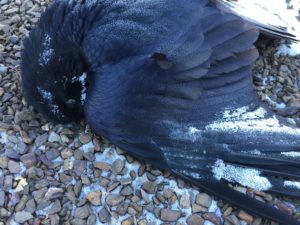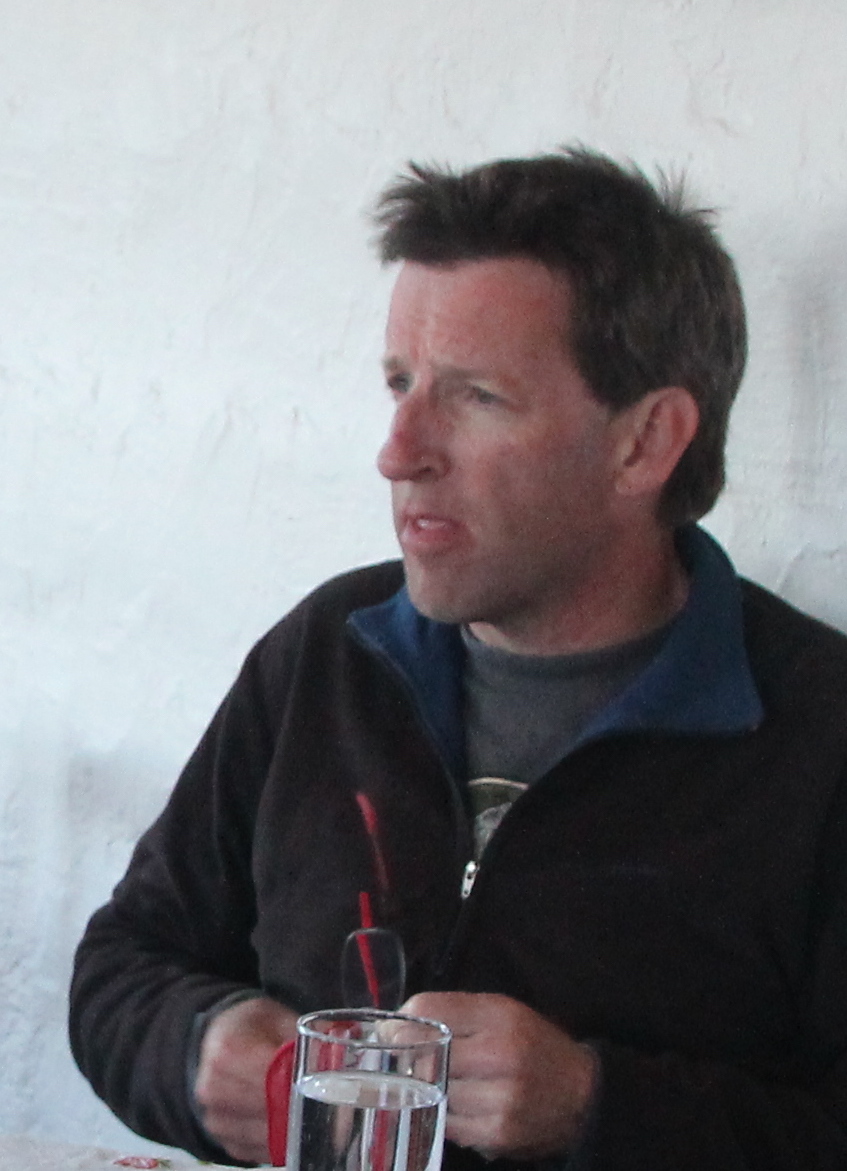 For the second time since the onset of cold weather, on the same morning walk with my son to the bus stop, a dead raven lies immobile down in the next block in the strip of gravel between the street and the sidewalk—the utilitarian zone that many people call, appropriately enough, the “death strip.” The lightest possible dusting of snow encrusts the feathers, producing a textural effect almost impossible to look away from, and same feeling that sometimes comes from a sudden glimpse of a painting, or a spring leaf, or the skin of a beloved—the realization that something usually overlooked has just blossomed into bottomless depth. Who knew that silky black feathers could look so intimate, so mysterious, so stop-in-your-tracks beautiful?
For the second time since the onset of cold weather, on the same morning walk with my son to the bus stop, a dead raven lies immobile down in the next block in the strip of gravel between the street and the sidewalk—the utilitarian zone that many people call, appropriately enough, the “death strip.” The lightest possible dusting of snow encrusts the feathers, producing a textural effect almost impossible to look away from, and same feeling that sometimes comes from a sudden glimpse of a painting, or a spring leaf, or the skin of a beloved—the realization that something usually overlooked has just blossomed into bottomless depth. Who knew that silky black feathers could look so intimate, so mysterious, so stop-in-your-tracks beautiful?
It’s as if this were the sort of description exercise I have my writing students undertake—find the right words and phrases to effectively make the reader feel that they’re there with you, looking at the feathers sprinkled with snow, the white and the black both colors-that-are-no-color-at-all.
Side question, in class: why does it read better to write “the white and the black” than simply “white and black”? That’s another lesson: rhythm, the nouns with their repeated articles a better simulacrum of breathing than the guttural nouns by themselves. Plus, the articles make it clear that what follows are nouns rather than adjectives, objects with a real physicality, which the raven and the sprinkling of snow most certainly are. How black are a raven’s feathers? Black through and through, so devoid of color that the result is a new color all its own—because exploring internal contradiction is one of the best of subjects for writing.
Description is satisfying, finding its culmination in the unearthing of the right word or phrase, a square peg finding a perfect fit in its hole. In its invocation of a crystalline moment, it might suffice to carry a poem. An essay, no. An essay needs more. Like character, for example. Why is it so jarring to find a dead raven? It’s hardly unusual to find a dead bird. I spot them pretty often: the broken-necked finch that slammed into a window, the gull washed in by surf and mounded with sand, the explosive spray of feathers where a hawk took down a dove. But a raven? They’re among the most widespread of birds in the West, they’re super-smart and super-talkative, and they can handle most any environment. Over three decades, ravens are the only bird species that has ever been tallied on the annual Christmas Bird Count at Prudhoe Bay, Alaska, where a few dedicated birders struggle to find enough daylight to look for birds for a total of three very cold hours. You can also find them in the hottest place in the U.S., in Death Valley. And that’s not even to mention the extent to which they have colonized our human-shaped environments, finding ample food in parking lots, dumpsters, along roads and, at least once, in a Ziploc bag full of trail mix that a careless hiker, namely me, left visible in an unzipped daypack along the Colorado River while taking a short stroll away from my campsite.
But what makes them seem eternal, and unkillable, is their smart-ass attitude. Just a week ago the Arizona Game and Fish Department put out a press release acknowledging that the nest of a pair of bald eagles had been raided by ravens. This might not ordinarily make the news, but in this case the nest was one, at Lake Pleasant, that the Department had decided to feature on a webcam. So some unknown number of viewers got to watch, live, as a pair of ravens landed on the massive pile of sticks while the parents were away and destroyed the single egg. One of the ravens looked to fly off with the eagle egg, but thought better of it, for some reason, and instead decided to eat the contents in situ. “Oh darn it. Stupid naughty ravens,” commented a YouTube viewer. That’s character.
(Not to worry, by the way, pointed out the agency press release; the female eagle laid another egg. Maybe now the pair of national symbols had learned their lesson, and would know enough not to both leave their nest at the same time. Eternal vigilance is the price of freedom, right?)
So ravens are sort of the coyote of birds, the trickster that’s always around, loping along at the edge of sight, ubiquitous but also maddeningly elusive. How could not one but two die just like that? The question gets us to another vital quality of the essay: the narrative arc. An essay has to move. An essay is ultimately a consideration of why, not just what. Which is why the key question here, as it was on the sidewalk, is: why is there a dead raven, especially the second one in only a few months? Ravens tend not to simply drop dead from the trees.
But they do sometimes simply drop dead from a utility pole. The one in question seems to be a popular spot for the ravens and their cousin crows. They are perhaps drawn by a serendipitous combination of tall leafless trees to perch in and, at least this winter, a good standing crop of winter-softened apples periodically loosed onto the sidewalk by wind and gravity. And sometimes they perch on the utility poles as well as in the trees.
Birds can’t be electrocuted by touching or perching on a single electricity-bearing cable, but they typically die instantly when they happen to brush against two cables, as long as one of them is live—a very literal arc. Many electric utilities have made good progress in recent decades in designing new equipment, or retrofitting existing utility poles, to make it difficult or impossible for birds to make that sort of contact. Above where the two ravens showed up, though, it does look to me like it would be possible for a large bird to inadvertently touch two cables, perhaps where a curved jumper cable comes down from the main power line to a transformer.
So there’s the why—I think. The narrative arc? It might be something as simple and final as an accidental brush against two cables, because even ravens aren’t smart enough to know to avoid that, and the resulting climax of instantaneous electrocution. Or maybe it’s: death of a bird, plus a pressing deadline, produces an exercise in writing about a small thing. Or maybe it’s: APS comes out to examine the pole so that there won’t be a third time. I hope so.

